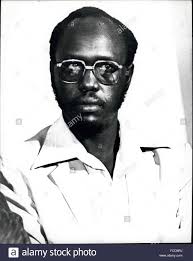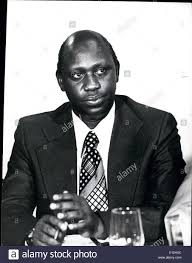By CHANGE OF GUARDS
When Iddi Amin overthrew the UPC government led by Milton Obote in 1971, different externally based groups crept up in a bid to resist the military government in Kampala. One such group was the Save Uganda Movement (SUM) that was founded in 1973 and was based in Nairobi, Kenya. It recruited from mainly Acholis who had fled to Kenya and settled around Kibera and Kariobangi slums. It adopted guerrilla tactics of sabotage through bombing of specific targets, raids and assassinations. Its leadership comprised Eteker Ejalu, Akena P'Ojok. Col. William Omaria, Yona Kanyomozi, Ephraim Kamuntu, Tarasis Kabwegyere, Richard Kaujuka, and others. It was comprised of different subgroups but with similar aims and objectives. Along the way, its ranks were boosted by defections from the Uganda Army under Iddi Amin and that is how the likes of Matayo Kyaligonza were its initial field commanders. Most significant is the fact that unlike the other dissident groups based in Tanzania that attracted Acholi and Langi, SUM attracted a sizeable number of Baganda and easterners, defecting soldiers, into its ranks.
Around March 1973, it had succeeded in assassinating a few low cadre government officials. In 1974, it attempted a coup against Iddi Ami and on June 10, 1976, a grenade attack on Iddi Amin at Nsambya. The June 17, 1977 foiled assassination of Iddi Amin in an ambush at Abaita Ababiri along Entebbe Road, several plotters were killed during the clashes while seven of them were taken hostage. The hostages who included Maj. Patrick Kimumwe who had been the 2nd in Command of the Malire Mechanized Regiment, Lt. Sylvester Nutumba, Pilot Cadet Nokodemus Kassujja, WO II Eddy Ssendaula, WO Ssekalo, WO John Okecho and Lt. Nambale were detained at the dungeons of the notorious State Reserch Bureau (SRB) headquarters in Nakasero. Three months later, in September 1977, five of the six hostages daringly escaped from the dungeons leaving behind John Okecho whose big body size could not allow him to go through the improvised exit point. This incident is said to have led to sacking of the then Director of SRB, Col. Francis Itabuka. Maj. Kimumwe and others found their way to Nairobi, Kenya from where they linked up with SUM dissidents.
In 1975, the then Deputy Commander of the Air Force, Col. Zeddy Maruru was dismissed from the army before he fled to exile in Nairobi where he linked up with SUM dissidents. In 1977, a re-known Play right, Robert Sserumaga fled Uganda for Nairobi where he joined SUM before he switched to head the Uganda Nationalists Organisation (UNO). Charity organizations and economically well placed individual Ugandans based in Nairobi like Dr. Bisase, Dr. Ssenabulya, Rogers Mukasa, Edward Mugalu, B. Mumanya offered support to exiled SUM dissidents in Nairobi. Interestingly, Rogers Mukasa who had even offered his car for use by these dissident soldiers in Nairobi turned around and reported that it had been stollen before the four soldiers were arrested and deported back to Uganda.
He mobilized the Ugandan dissident soldiers under SUM in Nairobi and established contact with the Obote faction of Ugandan exiles in Tanzanian. With approval of the Tanzanian government, the militant dissidents sneaked out of Kenya into Tanzania and were placed in a camp around Tarime District near Musoma near the shores of Lake Victoria. They were addressed by SUM's political leaders Robert Sserumaga and Col. Zeddy Maguru. A week later, truckloads of arms and ammunition that included artillery pieces and light arms were ferried in. The SUM militants were subjected to a three months intensive training and more especially on the support of weapons.
From the Obote militants camp in Tabora, another 300 men were picked and taken to the Tarime camp to be joined to the SUM militants in refresher training sessions. They were supposed to cross Lake Victoria and attack Entebbe Airport and over to Katabi Barracks before more reinforcements were to come by land through Mutukula. After the training, a reconnaissance party was dispatched to Uganda by land via Kenya. The party that comprised Lt. William Kimumwe (young brother of Maj. Kimumwe), Lt. Kibwika, Lt. Wante, Sgt. Balamu and Sgt. Njawuzi set off from Tanzania but as soon as they stepped on Kenyan soil they were arrested and sentenced to six months jail with hard labor. Back in the camp, the planned invasion went ahead. Col. Tito Okello, who was the head of the pro Obote militant dissidents, was at hand to give the final briefing to these militants. When he mentioned that the political leadership of the post Iddi Amin Uganda would he determined after the overthrow, the pro-Obote militants vehemently protested arguing that it must be nobody else other than the exiled former President Milton Obote. When the protest turned into riots, they broke into the armoury and acquired arms but could not easily locate the ammunition before they were overpowered by the Tanzanian Military Police. The ringleaders were rounded up and taken into detention while the entire camp was reprimanded. However a few days later, they were released and sent back to their camp in Tabora.
Around January 1979, two ships belonging to the defunct EAC were made available for carrying the militants. The smaller single deck ship under the command of Maj. Babula, Maj. Matovu, Col. Bazilio Okello, Col. Ochero Nangai, Capt. Nambale Capt. Sendaula, Capt. Oryem, Lt. Muwanga composed the striking force. The bigger double decker ship under Maj. Komome carried most of the troops on the top deck while the lover deck was loaded with arms and ammunition, three jeeps and other logistics. Four Torpedo boats of the Tanzanian army that were supposed to escort the two ships could not be seen after a shot distance. An hour later, the two ships were approaching the River Kagera Channel that crosses Lake Victoria to the source of the Nile in Jinja. The smaller ship carrying the 120 men was hit by a storm at around 2:00PM and it capsized leaving only 9 men to tell the story. The men in the bigger ship watched in shock as they also battled the storm. They dropped everything on board in the water including the clothes they were putting on. It became clear that they had reached near Uganda's Ssese Islands and the bigger ship had to turn back and sail to Musoma from where they were taken back to their camp in Tarime. At the camp, the UNO leader, Robert Sserumaga was despatched together with Odong, Lt. Muwanga, WO I Nsereko and Lumbago for a spy mission into Uganda via Kenya. Unfortunately, immediately after stepping on the Kenyan soil, they were arrested by the Police. The lake tragedy prompted the pulling back of the ground turkey from Tabora that had been waiting to cross the Mutukula border.
Meanwhile, SUM's Eteker Ejalu secured a training facility for his 50 men around Arusha in Tanzania before it was sneaked into Uganda around 1978 for sabotage missions targeting assassinations and fuelling of tensions. Around December 1978, SUM operatives crossed Lake Victoria from Kenya with a mission to destroy fuel depots, electricity lines and military outposts. Around early 1979, SUM's Eteker Ejalu signed a Unit Pact with Obote in Tanzania for affiliation to a joint operations dubbed National Revolt. It is this unity pact that culminated into the March 2-4, 1979 raid on Tororo barracks from Kenya that turned disastrous when the UA defeated the invasion and internal revolt. The other two factions of SUM, led by Col Omaria and Akena P'Ojok also boasted of a few hundred militants by 1978. Therefore, when the Tanzanian army decided to back the Ugandan dissidents for an open war against the Iddi Amin regime, SUM contributed a significant number of fighters to the Kikosi Malum.
At the Moshi Conference, SUM was represented by Eteker Ejalu, Yona Kanyomozi, Apollo Echeku and William Ekwaro. The UNO delegation was led by Dr. Ssenabulya and comprised Israel Mayengo, Andrew Adimola and Robert Sserumaga. SUM's Col. Zeddy Maruru became the Secretary of the UNLF's Military Commission. After the overthrow of Iddi Amin in April 1979, SUM leaders like Col. Omaria and Akena P'Ojok intensified their recruitment drive such that by September 1979, it had a formidable force that it surrendered to the UNLA. It's owing to its military power that Museveni reached out to them for an alliance during the formation of UPM in 1980. NOM simply melted in this air after the overthrow of Iddi Amin and Robert Sserumaga who had been appointed Minister of Commerce in the short-lived Prof. Lule government, died in Nairobi around September 1980 as he made plans to resume rebellion against Kampala. Matayo Kyaligonza joined Museveni's Bush War taking with him his SUM urban terrorism. Nambale served under UNLA before joining the NRA. Col. Zeddy Maruru was later to serve under the UNLA as a Bridage Commander and when Obote was over thrown, Zeddy became the army Chief Of Staff before the NRA took over in 1986.
Akena p'Ojok was elected Vice Chairman of UNLF and. narrowly missed becoming the president of Uganda after Prof. Lule. In 1980, Akena sought the leadership of UPM but was denied on account of regionalism in favor of Museveni. He won the Gulu West parliamentary seat on the UPC ticket before being appointed Minister of Energy, Posts and Telecommunications under the UPC government. He vehemently declined several offers by Museveni to serve under Museveni's government before he (Akena) was accused of aiding armed rebellion in 1987. Akena remained in detention without trial till 1990 when he was released at the mercy of Museveni and since then he has lived in London.
Eteker Ejalu became the Minister of Information and later Minister of Regional Cooperation under the post Iddi Amin governments. During the Obote II government, Ejalu was appointed the Managing Director (MD) of Uganda Railways Corporation. When Museveni came to power, Ejalu fled to Nairobi from where he was lured back before accepting a cabinet position and later Museveni's peace envoy for the northern and eastern Uganda insurgency. Col. William Omaria became a member of the UNLF's Military Commission before becoming an MP and Cabinet Minister under the Obote II government. Omaria fled to exile when Museveni took power.
This is what Museveni doesn't want the young generation to know as he falsely claims that his briefcase FRONASA fought the Idi Amin regime.
Have a Happy 35TH TAREHE SITA ANNIVERSARY celebrations.
INFORMATION IS POWER AND THE PROBLEM OF UGANDA IS MUSEVENISM





No comments:
Post a Comment
Note: only a member of this blog may post a comment.